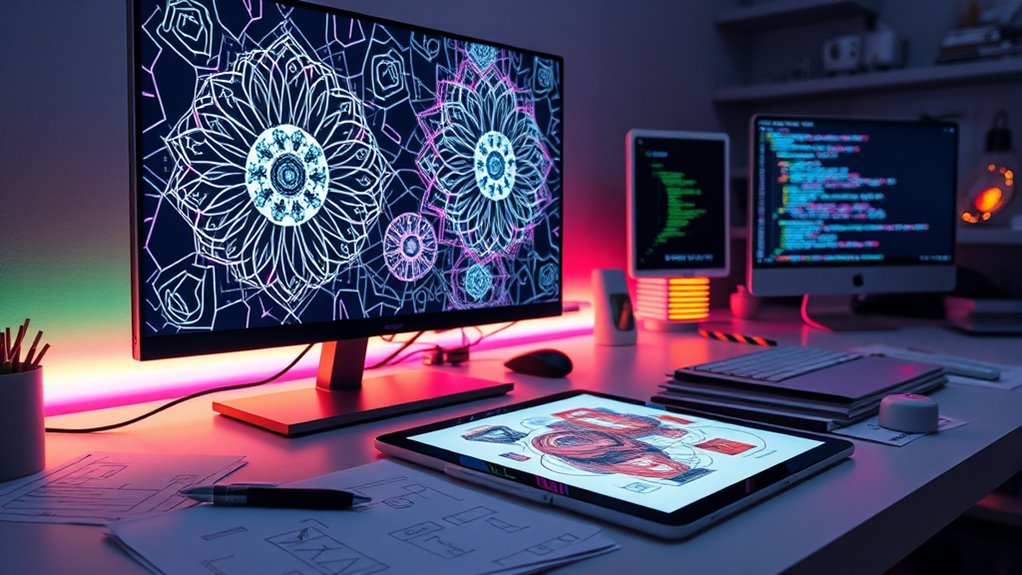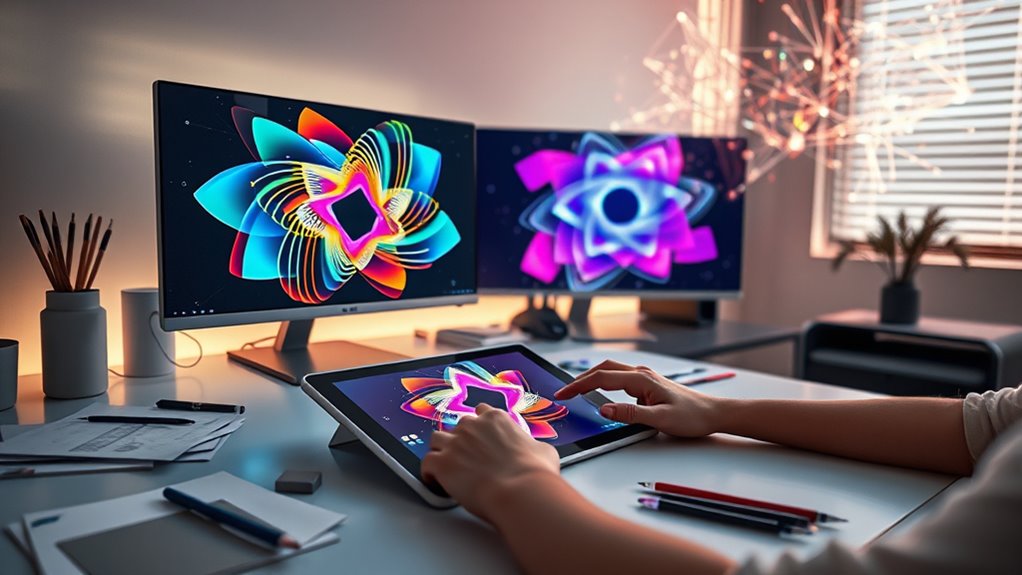AI-enhanced design lets you collaborate with generative tools to create stunning visuals, explore new styles, and refine ideas faster. These tools expand your creative options by producing diverse concepts quickly, helping you push beyond traditional boundaries. They work alongside your intuition, making the process more efficient and inspiring. However, it’s essential to contemplate ethical issues like originality and bias. Continue exploring to discover how responsible use maximizes AI’s creative potential while maintaining integrity.
Key Takeaways
- AI generative tools expand creative possibilities by rapidly producing diverse design concepts and variations.
- Collaborating with AI enhances workflow efficiency, enabling quicker idea exploration and refinement.
- Incorporating design thinking frameworks ensures responsible and ethical use of AI-generated outputs.
- AI acts as a creative amplifier, supporting experimentation while respecting originality and ownership rights.
- Transparent integration of AI fosters trust, accountability, and aligns design practices with ethical standards.

Have you ever wondered how artificial intelligence is transforming the way we create and innovate? AI creativity is opening doors to new possibilities, allowing designers to push beyond traditional boundaries and experiment with ideas that once seemed out of reach. Generative tools powered by AI can produce a vast array of designs, concepts, and visuals in a fraction of the time it would take manually. This collaboration can spark fresh inspiration, helping you explore styles, color schemes, or layouts you might not have considered otherwise. These tools don’t replace your creative intuition; instead, they act as amplifiers, giving you a broader palette to work with and refining your ideas more efficiently. Incorporating the design thinking framework into your process can help you systematically evaluate and iterate on AI-generated concepts.
However, as you integrate AI into your design process, ethical considerations come into play. It’s essential to recognize that AI-generated content is often based on existing data, which can raise questions about originality, ownership, and bias. For example, if an AI tool creates a logo or artwork inspired by existing works, who holds the copyright? Are you truly the creator, or is the AI’s influence overshadowing your personal input? Navigating these questions requires a conscious effort to understand the source of your AI tools and how they operate. Ensuring transparency and respecting intellectual property rights safeguard both your work and the broader creative community. Additionally, ethical AI use involves being aware of potential biases embedded in training datasets, which can inadvertently produce stereotypical or exclusionary designs. You need to critically assess the outputs, making sure they align with your values and the diversity you want your work to reflect.
Embracing AI creativity means balancing innovation with responsibility. It’s about harnessing generative tools to enhance your workflow without losing sight of the ethical implications. You have the power to shape how these tools evolve by staying informed and advocating for fair practices. As you experiment with AI, consider how your choices impact not only your work but also the creative ecosystem at large. Responsible usage involves transparency about AI’s role in your process and actively working to mitigate biases. By doing so, you guarantee that AI-enhanced design remains a force for positive innovation rather than a source of controversy or unintended harm. Ultimately, your role is to be a thoughtful creator, leveraging AI to unlock new heights of creativity while respecting the ethical boundaries that keep the creative community thriving.
Frequently Asked Questions
How Does Ai-Generated Design Ensure Originality and Creativity?
AI-generated design fosters originality and creativity by pushing innovation boundaries and inspiring new ideas. You can leverage these tools to explore unique concepts that might not emerge through traditional methods, ensuring your work maintains creative authenticity. By collaborating with AI, you stay ahead of trends, discover fresh perspectives, and produce designs that stand out, all while keeping your creative voice central. This synergy helps you craft innovative, authentic work that resonates.
What Are the Ethical Considerations in Ai-Assisted Design Processes?
You should consider privacy concerns, ensuring client data remains confidential, and be aware of accountability issues if AI produces biased or harmful designs. It’s essential to establish clear ethical guidelines, taking responsibility for AI’s output, and transparently communicate how AI influences your creative process. By addressing these concerns, you maintain integrity and build trust with clients, fostering a responsible approach to AI-assisted design.
How Can Designers Maintain Their Unique Style With AI Tools?
You can maintain your unique style by actively customizing AI tools to reflect your personal aesthetic. Experiment with AI customization options, set clear design parameters, and integrate your creative instincts into the process. Regularly review and adjust the AI outputs to guarantee they align with your vision. Remember, AI should enhance your style, not replace it—so stay involved, make deliberate choices, and infuse your personality into every project.
What Skills Are Essential for Effective Collaboration With Generative AI?
To collaborate effectively with generative AI, you need strong collaborative communication skills to clearly convey your ideas and feedback. Additionally, technical proficiency is essential to understand the tools’ capabilities and limitations. By combining these skills, you can guide the AI to produce outputs aligned with your vision, troubleshoot issues efficiently, and foster a seamless creative process that enhances your design work.
How Does AI Integration Impact Project Timelines and Budgets?
AI integration accelerates project timelines by automating repetitive tasks and streamlining workflows, helping you meet deadlines more efficiently. It also enhances cost management by reducing labor costs and minimizing errors. However, initial investments in AI tools and training can impact budgets. Overall, AI can optimize project delivery, but you should carefully plan for upfront costs to balance long-term gains in speed and savings.
Conclusion
By embracing AI-enhanced design, you harness creativity, boost efficiency, and push boundaries. You collaborate with generative tools to innovate, to iterate, to inspire. You adapt to change, learn from technology, and redefine what’s possible. In this partnership, you unveil potential, break barriers, and shape the future. Ultimately, it’s not just about tools or algorithms—it’s about your vision, your voice, your legacy. Together, you create something extraordinary that transcends limitations and transforms ideas into reality.









